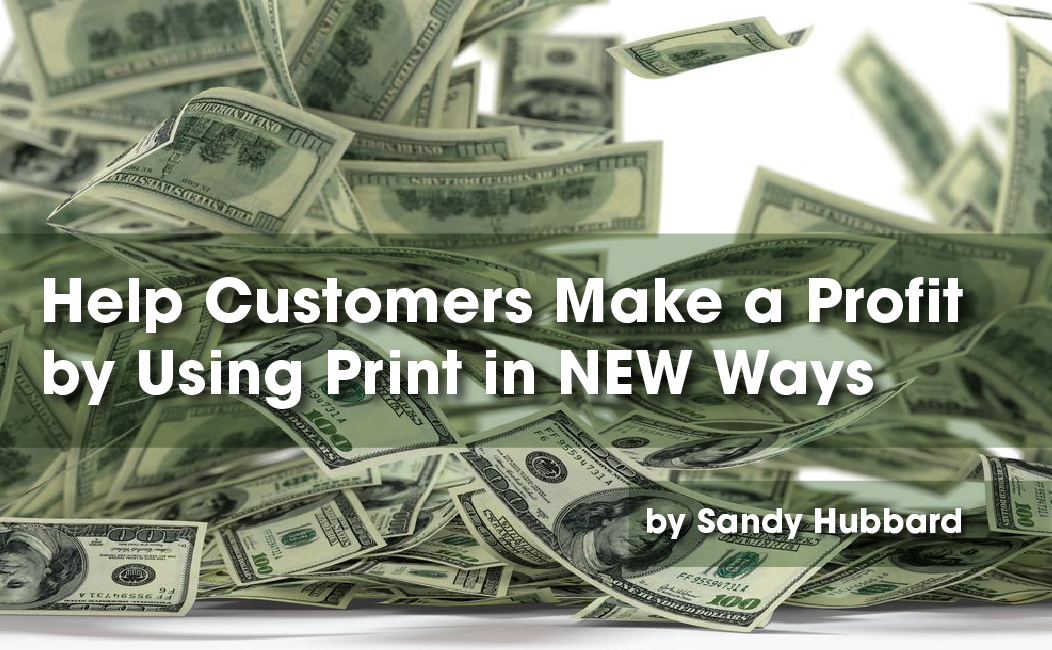
“If you want me to use print for marketing, make it the kind of print that makes me some money.”
My client told me he was leaving money on the table with every purchase. The will-call counter for his specialty parts business was so busy he had no time to upsell customers. “If we’re not on the counter, we’re working in back, packaging up parts to ship out,” he explained. “There’s no time to schmooze. We’re busy filling orders and nothing more.”
It was Friday afternoon, well past rush hour. I always visited the shop late in the day so I wouldn’t interrupt their work. I could sit by the woodstove, flip through motorsports magazines, and listen to their conversations
“Well?” I looked up. It was already starting to get dark, and they had not turned the lights on in the customer area yet. “Are you talkin’ to me?” I asked. My client’s brother chuckled as he weighed packages and applied labels. “I’m telling you that I could make a 50 percent markup on every sale,” my client said. “Tell you what,” I said. “I’ll come in during the week and talk to some of your customers. Let’s see what kind of money they’re willing to spend and what we can do about it.”
Well, it turned out he WAS leaving money on the table!
Mechanics and repair people do like keeping an inventory. They actually enjoy buying parts that they might need in a pinch. They like buying parts that would be hard to get otherwise. They like thinking about parts and they like talking about parts. They like opening the boxes after they get them, and they like laying everything out and looking at what they bought. Upon investigation, his customers revealed they DO have enough money to make an impulse purchase or two when they are picking up their order.
When I came back to my client with the results of my research, he said hrmmphh, which means “I told you so.”
“Whatever we’re going to do,” he said, “I don’t want a big mess. I don’t want people pawing through my counter catalogs. I don’t want to be explaining things too much. I don’t want people taking more time and backing up the line. I don’t want people to have buyer’s remorse and bringing things back. I just want them to buy one or two extra items every time they come in.”
It seemed like a tall order, but I had an idea. A friend of mine who was a fine artist also did excellent technical drawings. She actually knew my client. I came up with the concept of a printed bulletin that featured a technical drawing and description of one premium part, something that was interesting to mechanics and that would be the kind of part they would want on their shelves.
Each bulletin would be numbered and would feature a different part. We would not date the bulletins. We wanted people to collect them all. Frequency wise, in the summer during race season, we would publish more often. In the winter, just occasionally. I made the pitch to my client. I told him it was nothing fancy, a good experiment, we would see what kind of upselling results we would get.
His brother muttered from the shipping area, “Do it!”
Well, we ran two seasons and gross sales from the will-call counter went up 25 percent. Just about every third customer bought the part that we highlighted on the sheet. Customers came in more often to pick up the parts sheet, take it back to their shops, and put it in a notebook. Mechanics are like that. When it came to our little experiment, my client said, “I knew my idea would work.” I think I saw him smile. His brother smiled back at the shipping table.
We didn’t do huge long runs — only 2,000 at a time, sometimes every week and sometimes just once a month. For our printer, it was a nice regular job, printed black and white on two sides on a house sheet, and delivered at the printer’s convenience. Oh, and it was three-hole drilled so the mechanics could put it in a notebook. Easy job, decent markup for the printer, no hassle. I liked facilitating that kind of project. A win for the client and definitely a nice little cash flow for the printer.
Cash flow, especially.
As we go forward in this COVID world of business, I predict that runs will continue to get shorter. Print jobs will have to pay for themselves by increasing sales and bringing in new customers. Buyers won’t want a bunch of risk or stress, and they will lean towards simple projects. Some customers may have to pay as they go, and that will keep their projects modest.
Print salespeople will have to be especially creative.
In the COVID reality, printers can’t just take orders. They have to get “inside” their customers’ businesses and figure out firsthand where the opportunities are. When I say “inside”, I know what the reality is today. You can’t walk into a building and ask to speak to the buyer. You will have to use your best research and persuasive skills to get into a buyer’s organization, meet the right people, and get the money flowing. That’s right, you have to get the money flowing. And the best way to do that is to make sure the project will make additional money for the client.
And for my Main Street printers who say there is no money flowing right now, here’s a special message: You may be the owner, but you need to get out from behind the press. Get out from behind your counter. Even if you have to sit in a park somewhere with a cup of coffee and converse with a mask on, get out of your shop every day. Now, more than ever, people want to work with printers they know, like, and trust. You have to be out among the people, out in your community, to be today’s preferred provider.
Final note:
Everyone likes to work with easy customers. Learn how to work with the quirky customers, and you will always have money in your cash register and a smile on your face.
 Sandy Hubbard is an expert Marketing Strategist specializing in the Printing Industry. She consults with Print CEOs and owners of print, media, and platform businesses of all sizes — helping marketing teams build visibility and increase sales.
Sandy Hubbard is an expert Marketing Strategist specializing in the Printing Industry. She consults with Print CEOs and owners of print, media, and platform businesses of all sizes — helping marketing teams build visibility and increase sales.
Sandy is also co-host of #PrintChat, a weekly discussion on LinkedIn. Join the group here — and enjoy social media’s most popular chat for the global printing industry!











